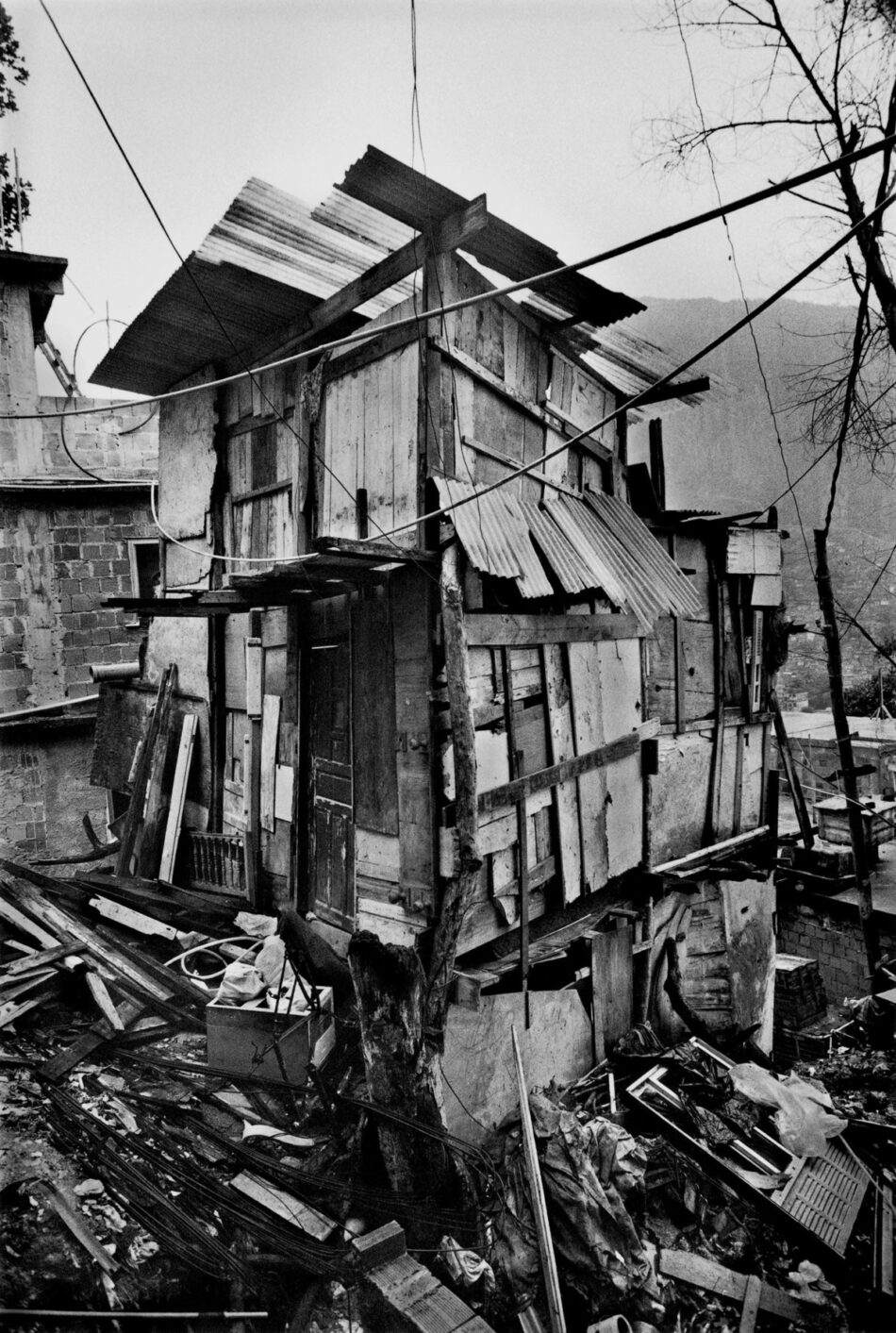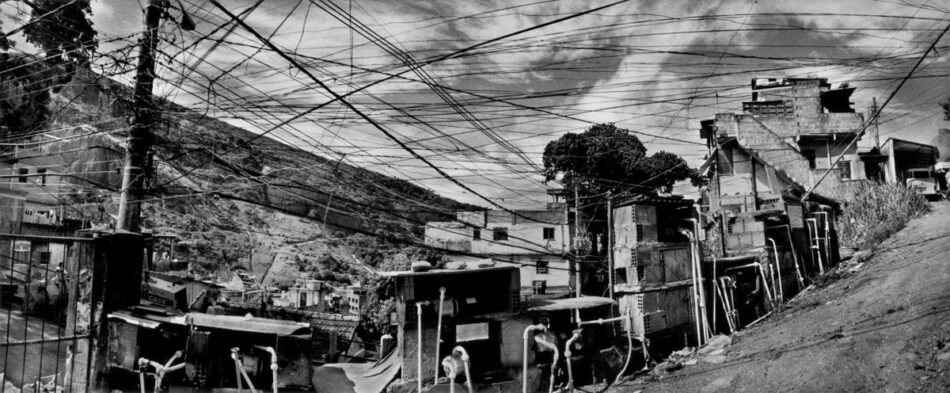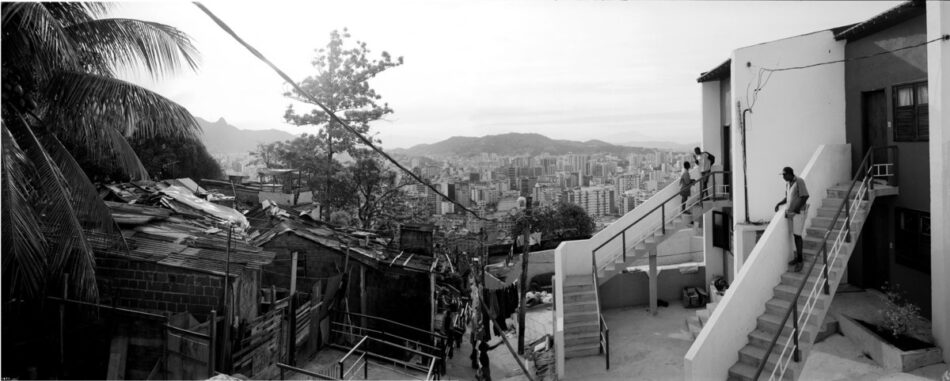A Billion Slum Dwellers and Counting
While Neuwirth’s historical analysis is useful, his optimism might be based on wishful thinking. As Davis makes clear, urban economies today are not growing as robustly as they were—if they are growing at all. Moreover, the settlements that Neuwirth chose to study are all exceptional in some way and thus more susceptible to optimistic narratives. Rocinha is one of Rio’s oldest and most established favelas, close to work and transportation, while Mumbai’s Dharavi is even more unusual. Slum dwellers generally have to go to the formal city to find employment, but Dharavi generates many of its own jobs, from leather and ceramics work to food production and even the manufacturing of medical devices.
In neither Davis’s book nor Neuwirth’s is there much sense of what might be done to improve life for slum dwellers. For this, turn to Informal City: Caracas Case, an anthology that brings together several short analytical texts on squatter settlements with proposals generated by a group called Urban Think Tank.5 The editors—Alfredo Brillembourg, Kristin Feireiss, and Hubert Klumpner—speculate that Caracas might be a model of urban evolution in the 21st century, with planned and unplanned, legal and extra-legal cities growing side-by-side, separate and unequal. They refer to their subject as the “informal city” because it is unofficial or outside the prescribed order. But they do not find it either disorderly or formless; indeed, they are at pains to describe the improvisational, self-organizing strategies that make these settlements work. (They deliberately avoid the term slum, which they consider too freighted with pejorative connotations.)
The ambition of Brillembourg, Feireiss, and Klumpner is to find a framework for best practices for upgrading informal settlements in Caracas, a framework that might be used in comparable situations elsewhere. Given the limitations of current monetary policy, they focus on low-cost, small-scale projects that create connections between the formal and the informal cities, a strategy they describe as “urban acupuncture.” Urban Think Tank pursues a more entrepreneurial practice than most design firms—they raise their own seed money, which is then supplemented by public funding—for projects like pedestrian bridges, stairs, and gymnasiums. Their notion is that small improvements will beget larger ones, that both residents and public authorities will be incited to make investments if someone takes the initiative. Such urban acupuncture is a very partial measure: Slope stabilization, new circulation, composting toilets, public spaces, and recreation facilities, however laudable, aren’t going to remake these communities entirely. Such measures have to be paired with massive upgrades to sanitation, transportation, and employment infrastructures, which can only be orchestrated at the national and international levels.
Informal City: Caracas Case is a valuable book, especially for the thoroughness of its analysis and its effort to think beyond housing to the provision of a habitable and economically viable environment. But it raises a host of questions. Are current, small-scale upgrading schemes complicit in neo-liberal policies that favor micro-enterprise and market-based solutions over more ambitious, state-sponsored macro strategies that might have a larger impact? Still more, can upgrading achieve significant permanent improvements or will it merely perpetuate social and spatial inequalities, with large percentages of the population packed into disproportionately small areas and cut off from basic services? Does the theory that small upgrades beget larger ones hold true in shantytowns? There is ample evidence that it works in the formal city, but will it work in slums?
Collectively, these books raise a larger set of issues. First, can we in fact define a set of best practices for slums, or are they simply too dispersed and too diverse to be susceptible to this sort of analysis? Enthusiasm is growing for on-site upgrading over slum clearance and relocation. Building right in the first place, however, is typically more cost-effective than retrofitting existing settlements. But relocation entails a social cost that needs to be factored in, and there is limited land available and little enthusiasm for the expenditures required for entirely new communities. So some combination of upgrades and selective, nearby relocations may represent an approximation of best practices — provided that relocations take culturally appropriate forms and allow for the mix of employment and housing that typifies squatter communities.
Second, how do low-income contexts affect design processes? Centrally planned interventions are generally dismissed as “top-down,” while community participation is celebrated as “bottom up.” But are these distinctions based on such clearly contrasting realities, and is it unambiguous that one is always better than the other? We have a lot to learn from squatter communities—about making do with less, about efficient uses of materials and space. But designers can bring a great deal of expertise to the alleviation of slum conditions, mediating among various interested parties and giving spatial form to their ambitions. In particular, they might be able to facilitate the transformation of vernacular slum typologies directly into 21st-century sustainable communities, with on-site energy generation, storm water collection, and sewage treatment wetlands.
So a rigid division between “top down” and “bottom up” may be counterproductive. Nonetheless, community participation in design can surely be improved. An inventive process, especially one that recognizes and develops local narratives, can facilitate or even inspire design outcomes. Are there inventive new strategies in the making? And who should take the lead in orchestrating community participation? Community organizations? Designers? NGOs? Is there a role for faith-based groups, or are they too polarizing?
Apart from climate change, there may be no more pressing challenge to planetary health and security than the fate of slum dwellers. Helping to improve the quality of life in slums is not rocket science, yet every indication is that we are falling farther and farther behind. The failures are probably more political than logistical or conceptual, and that might be the sorriest part of the whole story.




In 2003, the United Nations Human Settlements Program issued an alarming report on the status of the world’s urban poor. Called The Challenge of Slums, it concluded that nearly a billion people, primarily in the developing countries of the global South, live in circumstances that fit the classic definition of slums, circumstances characterized by overcrowding, substandard and/or informal housing, inadequate access to clean water and sanitation, and insecure tenure. The megacities of Asia, Africa, and Latin America lead the world in sheer numbers of squatters and tenement-dwellers: Mumbai (India), Mexico City, and Dhaka (Bangladesh) have about ten million apiece, followed by Lagos (Nigeria), Cairo, Karachi (Pakistan), Kinshasa-Brazzaville (Congo), São Paulo, Shanghai, and Delhi, with between six and eight million each. Upwards of 90% of urban residents in some places—Ethiopia, Chad, Afghanistan, and Nepal, for instance—live in slum conditions, while slum-dwellers constitute over 37% of the urban population in China, 55% in India, 79% in Nigeria, and 84% in Bangladesh. The number of slum-dwellers is expected to double by 2030; slums are now the dominant form of urban land use in much of the developing world. Globalization, it seems, is intensifying economic inequality, producing archipelagos of wealth in oceans of poverty—with potentially catastrophic consequences.
Mike Davis describes his sober and intelligent book, Planet of Slums, as an “appendix” to the UN report; his aim, he says, was to generate “a new global understanding” of current slum conditions and the historical circumstances that generated them. He argues that the current explosive growth of cities is taking place at a time of shrinking urban economies: In many places, agricultural deregulation, drought, falling commodity prices, disease, and war are continuing to drive people away from rural areas even as urban wages are falling, industries are downsizing or collapsing, and unemployment and prices are rising. This is a recipe for the mass production of slums; indeed, the growth of squatter settlements and shantytowns in many parts of the developing world outpaces urbanization itself. Cities, Davis insists, are becoming the dumping ground for a “surplus” of humanity.
Like the UN report before him, Davis assigns much of the responsibility for the recent surge in slum growth to the retreat of the state, occasioned largely by neoliberal structural adjustment policies mandated in the 1980s and 1990s by the International Monetary Fund and the World Bank. These policies required governments in developing countries to institute a variety of draconian measures—among them privatizing state industries, devaluing currencies, eliminating import controls and food subsidies, and slashing public spending—in exchange for continued access to loans.
But Davis digs deeper than this. In a chapter called “The Treason of the State,” he examines watersheds in the urbanization of poverty, notably the mass country-to-city migrations of the mid-20th century, a period of import-substitution industrialization,1 colonial counterinsurgency, and independence. In most places, government efforts to accommodate urban migrants fell far short of their goals—if they had any goals. Bad situations were worsened in a process Davis describes as “Haussmann in the tropics”: massive slum clearance and forced relocation of residents, often to distant locations far from employment and social services.
While Davis sometimes treats his subject a little generically, he is usually attentive to distinctions among slums: They vary widely in size, age, and level of political and social organization; some are in the centers of cities while others spring up on the peripheries; and though most occupy hazardous lands, these might be steep slopes, flood plains, or toxic dumps. Housing ranges from relatively consolidated to entirely provisional; some of it is hand-me-down, some is built specifically for the poor, and some is opportunistic (like tarps on sidewalks or under bridges and shanties in landfills or cemeteries).
Davis is equally attentive to the different ways that such settlements are established: While squatting might once have been the primary mechanism, a process that is less illegal than “extra-legal” is overtaking it. Davis describes this as “pirate urbanization”: settlements built without conformance to zoning or service regulations and enabled by bribes, populist governments, or property speculators who hope for eventual regularization and compensation for their investment. Whether illegal or extralegal, however, these settlements share certain desperate circumstances. In an excellent chapter called “Slum Ecology,” Davis examines the ways that poverty exaggerates the hazards of topography and climate—landslides, floods, and fires, for instance—and the pathological connections among density, inadequate sanitation, proximity to toxic industry, and disease.
Davis reaches two especially provocative conclusions. First he says that many of the classic urban safety valves no longer work; in particular, squatting no longer represents a free frontier for surplus urban populations. Urban land is less readily available than it was half a century ago, and much is privatized. Many slum dwellers have been forced to become renters, paying exorbitant fees to exploitative landlords. Indeed, the distinction between squatting and renting represents a fundamental social division in low-income contexts—squatters have potential access to equity through land-titling programs, while renters remain the poorest of the poor.
Second, Davis finds that informal economies, which provide most of the new jobs for urban migrants, are under increasing strain. Employment in the informal sector is not generated primarily through new initiatives but by dividing existing jobs and incomes; in stagnant or shrinking economies, more people are competing for diminishing amounts of work. Moreover, informal activity is not a guaranteed path into the formal economy, and it places a particular burden on women and children, since it lacks the protections and benefits of formal employment. Then too, Davis argues that increasing competition in the informal sector dissolves networks of self-help and begets racial or ethno-religious violence.
Davis sees the informal sector becoming increasingly desperate, preyed upon by militias and charismatic religious groups. In a bleak epilogue, he laments the absence of any “official scenario for reincorporating this vast mass of surplus labor into the mainstream of the world economy.” Only the military, he suggests, anticipating widespread urban insurgency, is contemplating the geopolitical implications of a “planet of slums.”
Many readers will find Davis’s perspectives excessively gloomy. Almost anything anyone has ever thought to try to help the urban poor is criticized, from the “sites and services” projects initiated by John Turner with the support of World Bank President Robert McNamara in the 1970s—a strategy of providing a building site with water and sewer hookups and leaving residents to build their own shelters—to the micro-entrepreneurial solutions advocated by Hernando de Soto in the 1990s. Even the non-governmental organizations (NGOs) that operate in slums are characterized as imposing a “soft imperialism” that bureaucratizes and de-radicalizes urban social movements. As a reviewer in Salon wryly noted, “reading Davis can be a bit like sitting down at a bar next to a guy who starts out lambasting the president and then proceeds to ridicule the opposition, leaving one with the impression that he doesn’t actually vote.”2
While many of Davis’s criticisms are valid, they can be lopsided. Sure, granting tenure helps squatters at the expense of renters, but isn’t half a loaf better than none? And no, not all sites and services projects worked out, but recent studies by Harvard students of settlements in Lima like Villa El Salvador suggest that at least some of them have matured into habitable places.3 Indeed, there may be cause for hope—at least for some settlements in certain economic and political circumstances. For instance, one of the oldest and largest of such extra-legal developments in Mexico City—Neza, home to some two million people—has developed over forty years from shantytown to a neighborhood with paved streets, sidewalks, and services. The possibility of this progression is likewise the theory of the Favela-Bairro (Slum-to-Neighborhood) Program in Rio,4 one of the world’s best-known slum upgrading schemes, which has had some success integrating squatter settlements with the formal city through improvements in circulation, transportation, sanitation, and public facilities including schools, sports centers, and community kitchens and laundries—the latter two intended both for the use of residents and for income generation.
Another problem with Davis’s argument is that it is based on an exposure to thousands of books and articles but very little first-hand experience. As a consequence, he is unable to convey much sense of the everyday lives of slum-dwellers. This is where Robert Neuwirth’s book Shadow Cities comes in handy—you should read the two together. What Neuwirth’s book lacks in trenchant social analysis or substantive policy understanding it more than makes up for in a close reading of what life is like in four settlements around the world: Rocinha, the largest favela in Rio de Janeiro; Kibera, a mud- and corrugated-metal-hut settlement of half a million in Nairobi; Dharavi, a vast squatter community in Mumbai; and Sultanbeyli, an extra-legal settlement in Istanbul with apartment houses, shops, mosques, and a seven-story squatter city hall. Neuwirth lived for a time in each and found they were not that similar—they manifest vastly differing levels of physical consolidation, social organization, and economic activity. They also reveal differing levels of official sufferance: In Nairobi, public authorities effectively prevent any improvement to what is essentially a rent plantation; in Istanbul, by comparison, laws guarantee at least some legal and political standing to squatters, insuring far better living conditions.
In all instances, however, Neuwirth finds evidence that people are adapting: They are demonstrating survival strategies that make life not only bearable but in some places and in some respects quite manageable. He conveys an optimism based to some degree on precedents: He provides ample evidence that—far from being a problem just of the developing world or the global South—slums are ubiquitous throughout history. Neuwirth’s most useful contribution might be his examination of the histories of European and American squatter communities. He finds them everywhere, from medieval London to 19th-century New York. This gives him reason to think that the same evolutionary processes that transformed slums into formal cities in the First and Second Worlds will also operate in the Third, although he is as skeptical as Davis when it comes to both slum-clearance projects and land-titling schemes (the latter, he thinks, will just turn squatters into speculators). Where titling is possible and social networks are strong, he favors the establishment of cooperative associations to hold and manage land.
* Books discussed:
Mike Davis, Planet of Slums (London, New York: Verso, 2006).
Robert Neuwirth, Shadow Cities: A Billion Squatters, A New Urban World (New York: Routledge, 2006).
Alfredo Brillembourg, Kristin Feireiss, and Hubert Klumpner, eds., Informal City: Caracas Case (Munich: Prestel, 2005).
—
1 Import substitution industrialization is a trade and economic policy based on the premise that a country should attempt to substitute products that it imports, mostly finished goods, with locally produced products. 2 Matt Steinglass, “A Swiftly Crumbling Planet,” http://www.salon.com/books/review/2006/03/14/davis/index.html. 3 See the spring 2007 GSD studio course “Urban Desert: Pampas de San Bartolo,” taught by Alexia Leon: http://www.gsd.harvard.edu/cgi-bin/courses/details. cgisection_id=9034&term=s2007. 4 http://www.fau.ufrj.br/prourb/cidades/favela/progfavbtIN.html. 5 On Urban Think Tank, see Wouter Vanstiphout and Michelle Provoost, “‘Facts on the Ground’: Urbanism from Mid-Road to Ditch,” Harvard Design Magazine 25 (Fall 2006/Spring 2007).